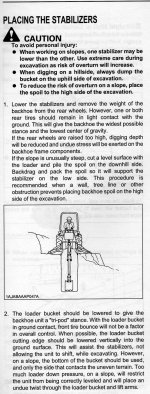It's not cylinder damage that would worry me. It would be structural cracking of the sub-frame, transmission, differential. These tractors are not structurally as robust as a 18,000 industrial TLB. It is much easier to twist the tractor while digging and swinging a load.
Have someone run your tractor with it up in the air as far as you can get it. Have them get a full bucket and with the boom/stick out, swing a loaded bucket quickly all the way to the stops. I haven't watched a BX or B with kubota hoe, but my guess is that you will see it flexing. Repeat that with the tires lightly touching. It won't be flexing near as much.
It would be interesting to have someone do the above and report back. That way we could have some first hand data and not speculation. Any takers?
jb
Have someone run your tractor with it up in the air as far as you can get it. Have them get a full bucket and with the boom/stick out, swing a loaded bucket quickly all the way to the stops. I haven't watched a BX or B with kubota hoe, but my guess is that you will see it flexing. Repeat that with the tires lightly touching. It won't be flexing near as much.
It would be interesting to have someone do the above and report back. That way we could have some first hand data and not speculation. Any takers?
jb


